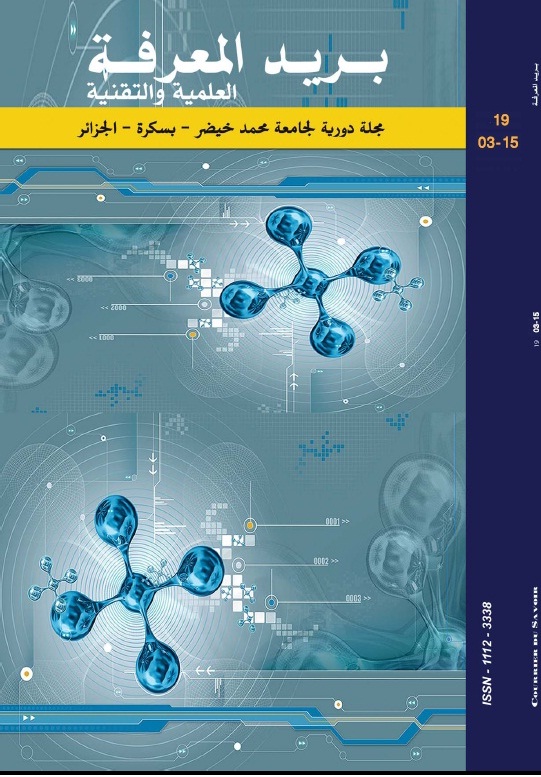PHASE STRUCTURE, MICROSTRUCTURE AND DIELECTRICS PROPERTIES OF NEW CERAMIC MATERIAL NEAR THE MORPHOTROPIC PHASE BOUNDARY
Résumé
ABSTRACT
This article investigates the sintering temperature effect on microstructure and dielectric properties of a new ceramic material :
Pb0.96Sm0.02Nd0.02[(Zr0.55Ti0.45)1-2x,x(Y2/3 Mo1/3),x( Y2/3Ni1/3)]O3 of perovskite structure , such that x =
{0.01,0.03,0.05,0.07,0.1}. In order to study well this system and delimiting the composition close to the morphotropic phase
boundary (FMB) in which the tetragonal and rhombohedral phases coexist, we varied the dopants ratio for that various
compositions were prepared by conventional solid state process. A thermal treatment was applied to these compositions at
different temperatures (1100, 1150, 1180°C), in order to optimize the sintering temperature where the density of ceramics is
maximum. We present the preparation and the different stages of the formation of the solid solution. Then we will detail the
different techniques of analysis applied to this compound, we begin first by x-ray diffraction, in the following, analysis by
scanning electron microscopy (SEM) and finally the study of physical properties (dielectrics). These studies help us to
accumulate as much information on these materials.
KEYWORDS: Ceramic; Microstructure; dielectrics.
Références
Ceram-ics,” Academic Press, New York, 1971.
[2] H. Y. Chen, X. B. Guo and Z. Y. Meng, “Processing
and Properties of PMMN-PZT Quaternary
Piezoelectric Ce-ramics for Ultrasonic Motors,”
Journal of Materials Chemistry and Physics, Vol. 75,
No. 1-3, April 2002, pp. 202-206.
[3] P. Ari-Gur and L. Benguigui, “X-Ray Study of the
PZT Solid Solutions near the Morphotropic Phase
Transition,” Solid State Communication, Vol. 15, No.
6, 1974, pp. 1077-1079.
[4] W. Cao and L. E. Cross, “The Ratio of Rhombohedral
and Tetragonal Phases on the Morphotropic Phase
Boundary in Lead Zirconate Titanate,” Journal of
Applied Physics, Vol. 31, 1992, pp. 1399-1402.
[5] K. Kakegawa, J. Mohri, X. Shrasaki and K.
Takahaashi, “Sluggish Pansition Between Tetragonal
and Rhombo-hedral Phases of Pb(Zr,Ti)O3,” Journal
of the American Ceramic Society, Vol. 65, October
1982, pp. 515-519.
[6] A. V. Turik, M. F. Kupriyanov, E. N. Sidorenko and
S. M. Zaitsev, “Behavior of Piezoceramics of type
Pb(Zr,Ti)O3, near the Region of the Morphotropic
Transition,” Soviet Physics-Technical Physics, Vol.
25, No. 10, 1980, pp. 1251-1254.
[7] K. Kakegawa and J. Mohri, “A Compositional
Fluctua-tion and Proporties of Pb(Zr,Ti)O3,” Solid
State Commu-nications, Vol. 24, December 1997, pp.
769-772.
[8] S. A. Mabud, “The Morphotropic Phase
Boundary in PZT Solid Solution,” Journal of
Applied Crystallographic, Vol. 13, 1980, pp.
211-216.
[9] C. Miclea, C. Tanasoiu, C. F. Miclea, L.
Amarande, A. Gheorghiu and F. N. Sima,
“Effect of Iron and Nickel Substitution on the
Piezoelectric Properties of PZT Type Ceramics,”
Journal of the European Ceramic Society,Vol.
25, No. 12, 2005, pp. 2397-2400.
[10] J. E. Garcia, R. Pérez, A. Albareda and J. A.
Eiras, “Non-Linear Dielectric and Piezoelectric
Response in Undoped and Nb5+ or Fe3+ Doped
PZT Ceramic System,”Journal of the European
Ceramic Society, Vol. 27, No.13-15, 2007, pp.
4029-4032.
[11] Z. Yang, R. Zhang, L. Yang and Y. Chang,
“Effects of Cr2O3 Doping on the Electrical
Properties and the Temperature Stabilities of
PNW-PMN-PZT Ceramics,” Materials
Research Bulletin, Vol. 42, No. 12, 2007, pp.
2156-2162.
[12] S. Takahashi, “Effects of Impurity Doping in
Lead Zirconate-Titanate Ceramics,”
Ferroelectrics, Vol. 41, No. 1, 1982, pp. 143-
156.
[13] C. A. Randall, N. Kim, J. P. Kucera, W. Cao and
T. R. Shrout, “Intrinsic and Extrinsic Size
Effects in Fine Grained Morphotropic-Phase-
Boundary Lead Zirconate Titanate Ceramics,”
Journal American Ceramic Society,Vol. 81, No.
3, 1998, pp. 677-688.
[14] Q. M. Zhang, H. Wang, N. Kim and L. E. Cross,
“Direct Evaluation of Domain-Wall and Intrinsic
Contributions to the Dielectric and Piezoelectric
Response and Their Temperature Dependence on
Lead Zirconate-Titanate Ceramics,” Journal of
Applied Physics, Vol. 75, No. 1,1994, pp. 454-
459.
[15] Ahmed BOUTARFAIA, ”Investigation of coexistence
region in lead zirconate -titanate solid
solutions: X-ray diffraction studies ”,Ceramic
International ,Vol.26, 2000,pp.583-587.
[16] R. B. Atkin, R.M. Fulrath.,”Point Defects and
Sintering of Lead Zirconate-Titanate”
Journal.American Ceram Society, 54[5],
1971,265.
[17] A. BOUTARFAIA, C. BOUDAREN, A.
MOUSSER & S.E. BOUAOUD ,” Study of
Phase Transition Line of PZT Ceramics by X-ray
Diffraction “, Ceramics International, Vol.21
,1995, 391-394,pp.391.
[18] B. GUIFFARD, Elaboration et caractérisation
de céramiques ferroélectriques de type PZT
fluore. Thèse de doctorat, Lyon ,1999.
[19] S. K. KORCHAGINA, L. F. RYBAKOVA, O.
L. PARKHOMENKO, N. V.SADOVSKAYA
and A. A. MIKHAILYUK, Rare-Earth-Doped
PbTiO3–PbZrO3 Solid Solutions, Inorg. Materi,
Vol 45, No 3, 2009, p 287 – 290.
[20] G. H. Haertling and C. E. Land, “Hot-Pressed
(Pb,La) (Zr,Ti)O3 Ferroelectric Ceramics for
Electrooptic Applications,” Journal of the
American Ceramic Society, Vol.54, No. 1, 1971,
pp. 1-11.
[21] A. Fawzi, A. D. Sheikh and V. L. Mathe,
“Effect of Magnetostrictive Phase on Structural,
Dielectric and Electrical Properties of
NiFe2O4+Pb0.93La0.07(Zr0.6Ti0.4)O3
Composites,” Solid State Sciences, Vol. 11, No.
11, 2009, pp. 1979-1984.


